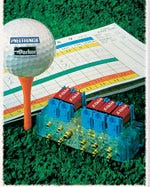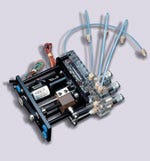April 6, 2001
Originally Published MPMN April 2001
PRODUCT UPDATE
Suppliers Introduce Smaller, Lighter Valves
System solutions popular among device OEMs
Because valves are an integral part of many medical devices, new technology is constantly being developed to provide OEMs with better solutions for their fluid and gas control needs. Valves used in production environments are also undergoing transformations. Concerns of manufacturers include shrinking the size of their finished products by integrating smaller valves, maintaining sterility, and preventing clogging during production. A wide range of valve types with a large selection of properties and capabilities is available to accommodate any manufacturing requirement. Following are examples of some recent developments in valve technology.
Valve manifold features a range of configurations
|
The small size and flexibility of Pneutronics' X-System allow device OEMs to reduce the size of their products without sacrificing functionality. |
As the medical device industry moves toward smaller and smaller finished products, suppliers are searching for new ways to reduce component size. Traditionally, valve manifolds are machined out of metal or plastic that may be heavier than desired, and can require special designs that are costly and time-consuming. In response to the demand for smaller, lighter valves, Pneutronics Div. of Parker Hannifin has incorporated its X-Valve into the X-System, a configurable manifold.
The X-Valve is an 8-mm-wide, two-position, three-way digital valve. The body incorporates all functional features in one glass-reinforced polybutylene terephthalate molded body. By combining the body and coil unit, the X-Valve can handle high flow rates at pressures from 0 to 30 psig. Vertically oriented electrical pins and female receptacles facilitate the use of common connectors. In addition, the X-Valve features a <10-millisecond response time and weighs 4.5 g.
Through the use of plastic components, the X-System provides a lightweight, durable assembly that can snap together with short lead times. It features a wide range of design configurations that can be tailored to suit various applications. "The X-System allows OEMs to radically shrink package size without losing the capabilities of much larger manifolds," says sales and marketing manager Bill Nissim. With an elastomer base for screwless assembly and fewer functional parts than most designs, the X-System minimizes tolerance issues and the potential for leaks.
Integrated fluidic platform consolidates fluidic components
|
Kloehn's system integrates solenoid valves and other fluid-control components to form one compact device. |
Although a reduction in valve size is helpful to many medical device designers, they face another problem when combining valves with manifolds and pumps. Devices that use several fluidic components may require multiple suppliers and are sometimes bulkier and more costly than desired. In order to balance manufacturing needs with available technology, Kloehn Company, Ltd. has developed an integrated fluidic platform (IFP) that combines solenoid valves, manifolds, pumps, drive mechanisms, and fluidic lines. "The desire of OEMs to pursue smaller, more reliable fluidic systems for use in their equipment has allowed us to focus our efforts on integrating our broad line of fluidic components into a complete system," says vice president of business development John Delameter. "The IFP package can incorporate multiple devices and fluidic circuits, allowing for reduced package size and lower costs." An integral part of the IFP, the solenoid valve features low power consumption; chemically inert, the valve is available in two-way, three-way, manifold, and other multiport configurations.
Positive-displacement valve offers smaller shot sizes
As devices get smaller, manufacturers can increase their joining capabilities by decreasing shot sizes. Dispensit recently developed the Model 1230 positive-displacement dispense valve that features a 0.01-0.5-cm3 shot size, making it suitable for UV-curables and other adhesives and fluids. A variation on the pinch valve, the positive-displacement valve expands on the pinch-tube design with the incorporation of a metering rod. The valve is pneumatically actuated and can be combined with a servo or stepping motor to provide continuous flow or variable amounts of material.
The Model 1230 is divided into two parts: a wetted module that contains the metering chamber, and a power head module that pneumatically drives the metering rod. It is made of corrosion-resistant plastic and stainless steel. "The modular design of the Model 1230 dispense valve allows for easy maintenance and material changeout," says sales and marketing manager Mike Bloomhuff. It is suited for medical OEMs because of its high degree of accuracy and repeatability, he adds.
Pinch valves enable smooth, sterile operations
Some medical and surgical procedures require that fixed equipment be used for several patients. To ensure the sterility of transfer liquids or gases, manufacturers can use pinch valves with replaceable sterile tubing sets. Available from Bio-Chem Valve Inc., pinch valves that manage the liquid or gas flow within an instrument are designed to allow the sterile silicone tubing to slide out for easy removal and quick replacement. By eliminating the need for disassembly or removal of the valve from the equipment, patient contact is restricted to the sterile tubing.
The USP Class VI silicone tubing reduces the potential for clogging and sticking of aggressive fluids or blood within the instrument. "Pinch valves offer a combination of high reliability and low cost for equipment dealing with liquids that contain contaminants or particulates that could damage or clog other valves," according to company president Adam Meyers. Bio-Chem's pinch valves feature precision fluid control, an on/off function, and fluid-stream switching. They are available in normally closed, normally open, or three-way configurations. Inner-diameter tubing sizes range from 0.1 to 0.875 in. The valves are suited for devices used to isolate and divert the flow of high-purity fluids, blood, or saline in applications such as irrigation and aspiration, dialysis, and ophthalmology.
New ball-valve design reduces leakage
Because they can handle extreme pressures and a wide range of liquids and gases, ball valves are often used in sterile manufacturing environments. Although they are easy to use and have good high-temperature and high-pressure characteristics, ball valves rely on upstream system pressure for shutoff, resulting in the potential leakage of contaminants. Swagelok Co. has developed a compensating seat design for its 60-Series ball valves that maintains constant load on the seat against the ball on the upstream and downstream sides. A coned disk spring and support ring ensure a leaktight seal between the seat and the ball, even in the absence of back pressure. "Every bioprocessing system engineer is concerned about properly cleaning a system, but also about keeping it contamination-free following sterilization," says Neil Gavin, company biopharmaceutical market specialist. "As steam cools within the system, a vacuum can be created that tends to pull contaminants through the leaky stem seals that are inherent in most ball valves. When this occurs, the sterile condition is compromised."
The 60-Series ball valves have a two-piece chevron live-loaded packing that helps to prevent inboard and outboard leakage by compensating for changes in pressure or temperature. The valves are available in sizes from ¼ to 2 in., with a variety of handle, vent port, and remote actuation options. Available end connections include tube fittings in metric and fractional sizes, ISO tapered pipe-fitting ends, tube and pipe socket weld ends, and butt weld ends.
Needleless luer valves replace access ports
In order to comply with stricter safety requirements for medical devices, a line of valves has been developed to replace needle ports in IV applications. Offered by DirectMed, they are designed to fill, hold, and release a controlled amount of fluids on demand. Instead of using a needle to access fluid-delivery systems, the valves are activated by pressing and locking a regular syringe to the access port. "By providing needleless access to fluid-administration sets, medical device manufacturers can comply with the latest legislation for the prevention of needlestick injuries to healthcare providers," according to vice president of sales Louis Pagliara.
Benefits of the valves include high flow rates, 0.1-ml priming volume, and 60-psi back pressure. A hermetic seal between the syringe luer tip and the valve reduces leaks and ensures a minimal backflow upon syringe removal. The valves are made of gamma-stable, USP Class VI materials that are free of latex and diethylhexylphthalate. The valve stem and body mate securely with standard luer syringes and connectors.
Katherine Sweeny
Copyright ©2001 Medical Product Manufacturing News
You May Also Like




